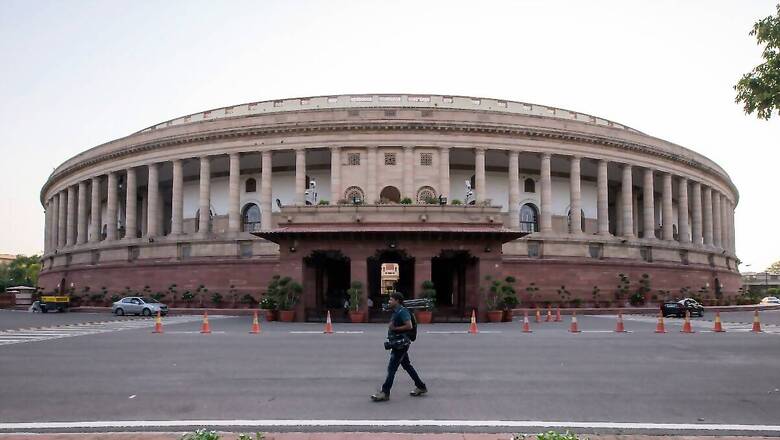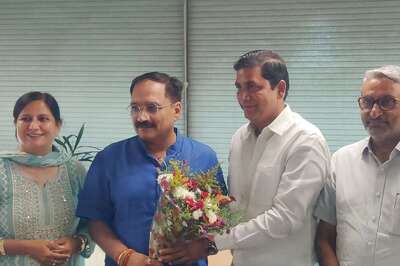It Costs Rs 2.5 Lakh Per Minute to Run Parliament. Here’s How Chronic Logjams Are Wasting Your Money

views
In December 2016, Member of Parliament Baijayant Jay Panda announced that he would return his salary “proportional to time wasted/lost” during the Winter Session which was the least productive among 10 sessions since 2014. But that would not stay the benchmark as Parliament had witnessed in the past and was to witness in the future several such “unproductive” sessions.
The Monsoon Session of Parliament, which started on July 20, ended in adjournment without any work on the first day as opposition parties staged a protest over the situation in Manipur.
As the stalemate continues for the fifth day in a row, an important question arises — how far is this logjam justified, given that it leads to huge loss of money and time meant for deliberating upon policies and legislating laws for the welfare of people.
The Budget Session, which was convened in two legs from January 31-April 6 and February 14-March 12, also got washed out as opposition parties stalled the proceedings. It recorded the lowest productivity of a budget session in five years.
According to a report by PRS Legislative Research (PRS): “Entering the final year of its term, the 17th Lok Sabha has functioned for 230 sitting days so far. Of all the Lok Sabhas that completed the full five-year term, the 16th Lok Sabha had the lowest number of sitting days (331). With one more year remaining in the term, and 58 average sitting days a year, the 17th Lok Sabha is unlikely to sit for more than 331 days. This could make it the shortest full-term Lok Sabha since 1952.”
As per the PRS report in the Budget Session, Lok Sabha functioned for only 45.9 hours out of 133.6 — the targeted hours — and Rajya Sabha worked for just over 32.3 hours out of the targeted 130 hours.
In August 2021, amid the Pegasus row, the Opposition stalled the proceedings of Parliament which could function only 18 hours out of the targeted 107 hours.
This loss of working hours becomes more disturbing when explained in monetary terms.
In the wake of the government’s decision of demonetisation, Opposition stalled the Winter Session of Parliament in December 2016. According to a report published by IndiaSpend, “Based on salaries, perks and the cost of running Parliament, about Rs 144 crore (Rs 138 crore on running the houses plus Rs 6 crore as salaries and perks paid) was lost due to disruptions during this winter session”.
As per an NDTV report, in 2021, more than Rs 133 crore of taxpayer money was wasted during the Monsoon Session because of disruptions.
In 2012, when Congress-led UPA was in power, the entire Monsoon Session was completely washed out over the controversy on coal block allocations. At that time, the UPA government had released an official figure according to which each minute of running parliament during sessions costs the exchequer Rs 2.5 lakh.
Then Parliamentary Affairs Minister Pawan Kumar Bansal, while elaborating on the costs incurred to run Parliament, had said: “In one year, Parliament runs for 80 days during sessions. Each day, business in both Houses is transacted for around six hours. If we consider the total annual expenditure, then each minute of running the House costs Rs 2.5 lakh.”
If we adjust this amount to account for inflation, the cost per minute would be much higher than Rs 2.5 lakh.
The cost of building the new parliament was around Rs 1,250 crore and it is expected that the new building will be used to deliberate upon important issues concerning common people. However, only time can tell if the new premises will be able to put an end to the old trend of disruptions.
It is not that our lawmakers cannot ensure the smooth functioning of Parliament. The first session of the 17th Lok Sabha is a good example in this regard. According to the PRS report, during the Budget Session of Parliament from June 17, 2019, to August 7, 2019, Lok Sabha worked for 281 hours, which was 135 per cent of the scheduled hours. This was higher than any other session of Parliament in the past 20 years.
On an average, Lok Sabha has worked for 81 per cent of its scheduled time in the past 20 years. Rajya Sabha worked for 195 hours, which is 100 percent of the scheduled hours. On average, Rajya Sabha has worked for 76 per cent of its scheduled time during a session in the past 20 years.
The most common reason for disruption of Parliament has been a controversy raked up by opposition parties for political considerations.
Chakshu Roy, head of legislative and civic engagement initiatives at PRS, in his article titled ‘The Cost of Parliamentary Disruptions’, makes two important points. First, he aptly highlights the fact that “a decline in the productivity of Parliament impairs its ability to effectively perform the duties that have been entrusted to it by the Constitution”.
He adds, “With Parliament being disrupted routinely, Members of Parliament (MPs) are not able to ask ministers tough questions during question hour to assess the work that their ministries are doing. With disruptions eating into the time available for parliamentary business, adequate time is not available for debating legislation. As a result, bills either get passed without effective debate or remain pending in Parliament. With Parliament meeting for a fewer number of days and with its productivity falling on account of disruptions, MPs are not able to raise matters of urgent public importance and bring it to the attention of the government.”
Commenting upon the controversies leading to disruption, he writes, “It is easy to identify political controversies which lead to parliamentary disruption. However, these political controversies are only the symptoms and not the cause of disruption.
“In every democracy there would be contentious issues and the strength of a democracy would be demonstrated by the quality of debate and deliberation on such issues. For debate and deliberation to happen, the parliamentary procedure would have to evolve to enable political parties on different sides of the issue to set the agenda for debate and discuss the issue in detail on the floor of the house. This would also require Parliament to meet for more number of days in a year and sit for longer hours. This would ensure that even if the proceedings are disrupted there is still enough time for deliberations.”
It is high time that our lawmakers rise above partisan interests, avoid political squabbles, and use the Parliament for constructive deliberations and to make laws for the development and welfare of people instead of settling political scores.


















Comments
0 comment